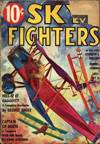Frederick Blakeslee painted all the covers for the entire run of Dare-Devil Aces. And each of those covers had a story behind it. This time, we have more of the approach he used for the covers he painted for Battle Aces—telling us about the ship on cover. But, instead of Mr Blakeslee telling us about the ship on the cover, we have Mr. Robert H. Rankin, formerly a draughtsman for the Fokker Aircraft Corp telling the story of the Sopwith 1½ Strutter on the cover of the May 1935 cover of Dare-Devil Aces. . . .
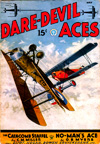
Editor’s Note: This is a surprise cover. In painting it, Frederick Blakeslee attempted to tell no story, but simply painted a ship for your collection. The color and every detail on the ship is exactly as it is on the original. We are very anxious to know how you like this cover. Write to Frederick Blakeslee in care of this magazine and tell him what type of cover you like best.
Sopwith 1½ Strutter
by ROBERT H. RANKIN
Formerly Draughtsman, Fokker Aircraft Corporation
WITH the exception of Fokkers, the Sopwiths were in all probability the best-known fighting ships used during the World War. The Sopwith Camels did more to repulse the German attempts at aerial supremacy than any other type or make of plane, while the Sopwith Pups and Triplanes made themselves almost equally as famous.
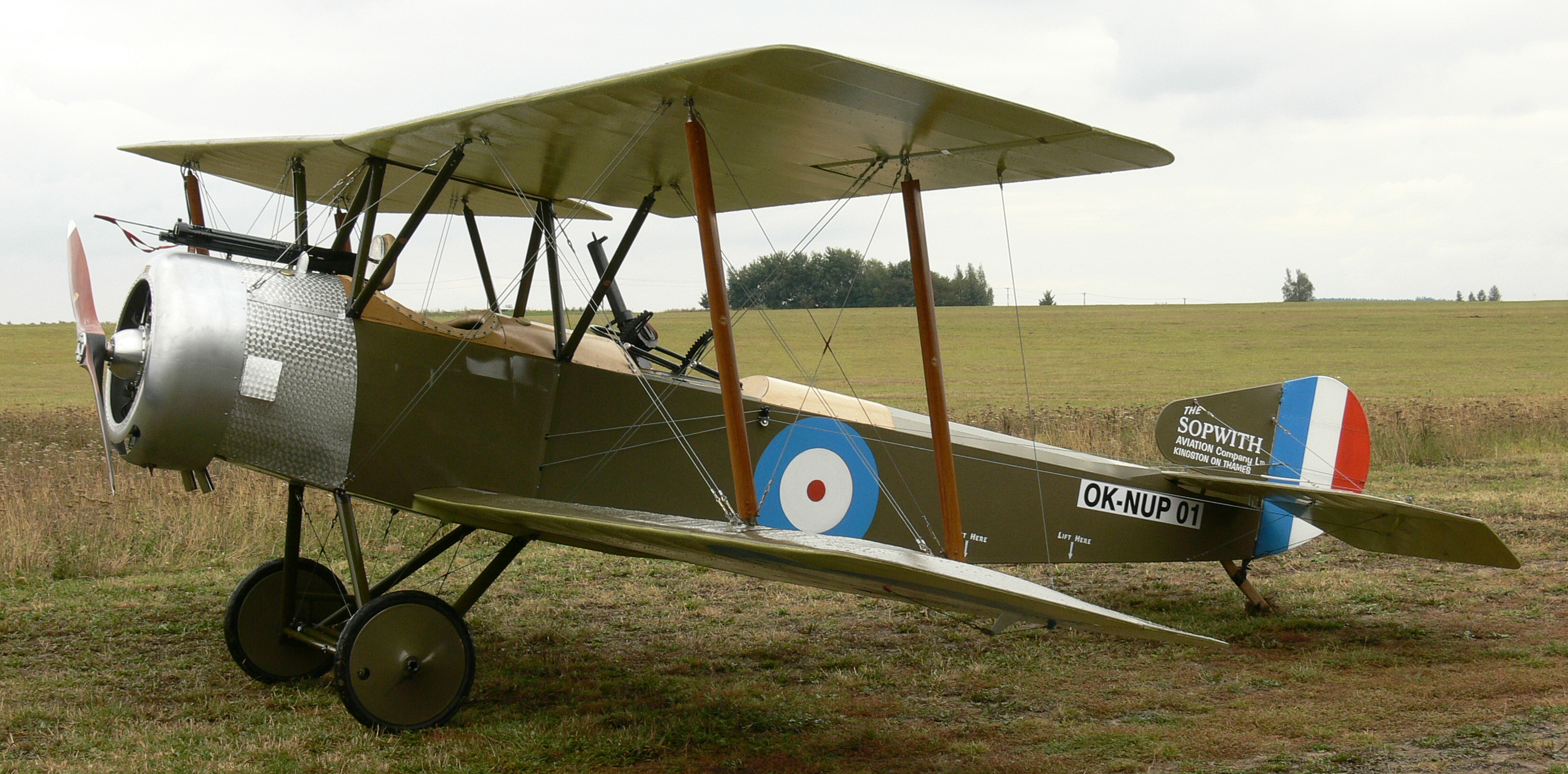
Although not as well-known as the other Sopwith models, the 1½ Strutter has a definite claim to historical distinction, not only because it was a great fighter, but because it was the first British plane to be fitted with a gun synchronized to shoot through the propeller.
The Sopwith-Kauper synchronization gear which made this possible was developed at the Sopwith factory and was as much a product of that firm as was the ship to which it was fitted.
The 1½ Strutter was originally designed as a high-performance two-seater fighter powered with the 100 h.p. Clerget engine. As such it gave a very good account of its self, showing an excellent performance and a decided ease of maneuverability.
In view of its worth as a fighter, many 1½ Strutters were built to the order of the governments of Roumania, Russia, Belgium, and the United States. In addition to this, the French government, under license, built more than 4,500 of these machines.
Structurally the 1½ Strutter was interesting in several ways. The wing bracing, which gave the ship its name, was rather unusual, for the top plane was in two halves, bolted to the top of a central cabane, while the wing spars were provided with an extra support in the shape of shorter struts running from the top fuselage longerons to the top plane spars some distance out.
In the single-seater pursuits which followed the 1½ Strutter, this bracing of the top wing was generally adopted, with the exception that the central cabane was done away with, the outer struts of the W formation having a slightly less pronounced slope, and supporting a separate top wing centersection.
Aerodynamically the machine is of interest because of the air-brakes with which it was fitted. These were in the form of adjustable flaps in the trailing edge of the lower wings. These flaps could be rotated by the pilot until they were normal to the wind, thus helping to pull the plane up as it was about to land.
Another innovation incorporated in the 1½ Strutter was the trimming gear by means of which the angle of incidence of the tail plane could be altered in flight. This allowed the tail to be adjusted for speed, climbing, etc.
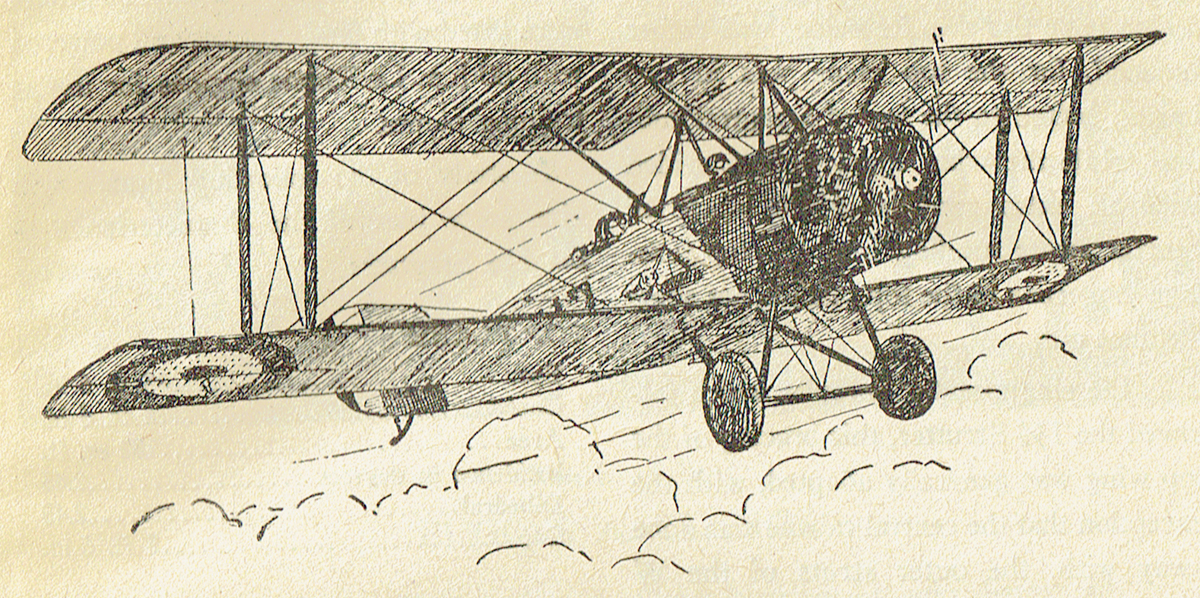
Although designed originally to be used as a two-seater fighter only, the 1½ Strutter was later successfully adopted as a single-seater bomber, and as such it was used in bombing such German towns as Essen, Munich, and Frankfort. For bombing service the machine was equipped with the 130 h.p. Clerget.
Later this higher-powered engine was used in the standard two-seater fighters. After the war a number of these fighters were fitted with dual controls and powered with 80 h.p. Le Rhone engines for use as training planes.
A study of the following figures will give some idea of the characteristics of the 1½ Strutter:
| TOP PLANE |
| |
|
| Span |
33 ft. 6 in. |
| Chord |
S ft. 6 in. |
| Area |
183 sq. ft. |
| Incidence in degrees |
2.45 |
| Dihedral |
2.45 |
| Gap |
5 ft. 5 in. |
| |
|
| BOTTOM PLANE |
| |
|
| All dimensions the same as for the top plane. |
| |
|
| GENERAL DIMENSIONS |
| |
|
| Total wing area |
373 sq. ft. |
| Length over all |
25 ft. 4 in. |
| Stagger |
2 ft. 0 in. |
| Sweepback |
0 ft. 0 in. |
| Aileron area |
52 sq. ft. |
| Tail plane area |
35.5 sq. ft. |
| Elevator area |
21.5 sq. ft. |
| Fin area |
3.5 sq. ft. |
| Rudder area |
7.25 sq. ft. |
Powered with the 110 h.p. Clerget engine, the two-seater fighter weighed 1,281 pounds empty, had a high speed of 130 m.p.h. and climbed 6,500 feet in 10½ minutes. The ceiling was 16,000 feet, the military load 160 pounds, and the landing speed 35 m.p.h. In addition to the fixed gun, the fighter carried a Scarfe ring and gun for the use of the man in the rear pit.
As a bomber, powered with the 130 h.p. Clerget, the ship weighed 1,316 pounds empty, showed a high speed of 102 m.p.h., and climbed to 6,500 feet in 12.7 minutes. The ceiling was 13,000 feet, the military load was 344 pounds, and the landing speed 35 m.p.h.
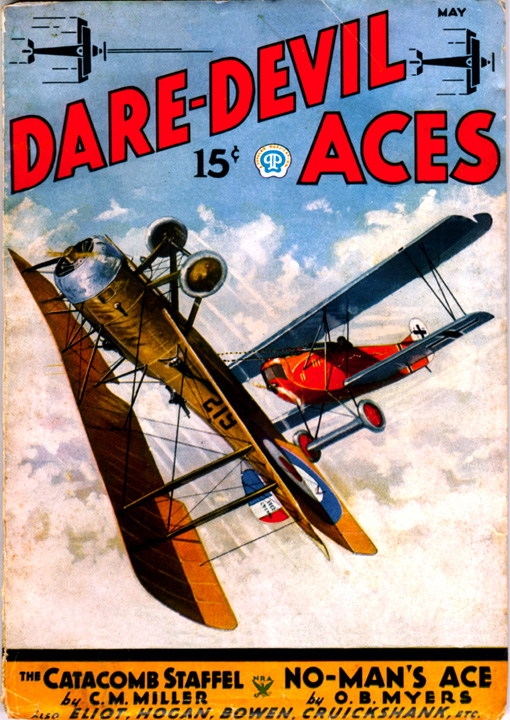
“Sopwith 1½ Strutter” by Frederick Blakeslee (May 1935, Dare-Devil Aces)
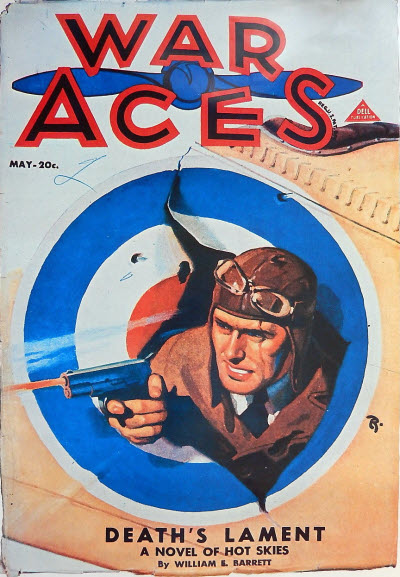 of our Barrett celebrations we have “Death’s Lament”—the story of Billy North who left home to fight in the war to avenge his brother’s death, but is stuck flying in the observation squadron where they fight the war with pencils rather than bullets!
of our Barrett celebrations we have “Death’s Lament”—the story of Billy North who left home to fight in the war to avenge his brother’s death, but is stuck flying in the observation squadron where they fight the war with pencils rather than bullets!






